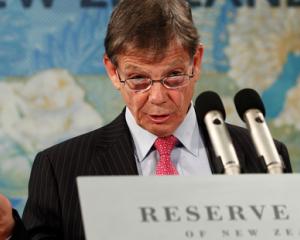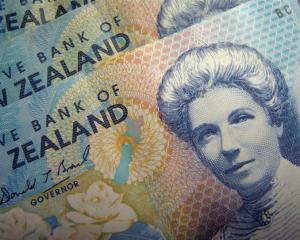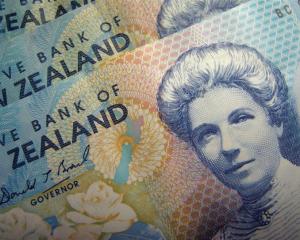Reserve Bank governor Graeme Wheeler has lifted the official cash rate for the second time in as many months, saying non-tradable inflationary pressures were "becoming apparent" in an economy that's picking up pace and he's watching the impact of a strong kiwi dollar on import prices.
"Spare capacity is being absorbed and inflationary pressures are becoming apparent, especially in construction and other non-tradable sectors," Wheeler said in a statement.
He lifted the OCR 25 basis points to 3 percent, saying interest rates need to be at a level where they don't add to demand so as to keep inflation expectations contained.
"The speed and extent to which the OCR will be raised will depend on economic data and our continuing assessment of emerging inflationary pressures, including the extent to which the high exchange rate leads to lower inflationary pressure," he said.
The kiwi dollar climbed to 86.06 US cents from 85.80 cents immediately before the statement was released. The trade-weighted index gained to 80.11 from 79.87.
Government figures last week showed inflation was 0.5 percent in the first three months of the year, missing estimates of 0.7 percent, with the headline number dragged down by a strong currency reducing the price of imported goods and services. Non-tradable inflation rose at an annual pace of 3 percent in the period, underpinned by rising housing-related costs.
Wheeler said the strong kiwi dollar was still a headwind to the tradable sector, and that "the bank does not believe the current level of the exchange rate is sustainable."
Slower-than-expected first-quarter inflation and a recent drop in dairy prices had fuelled speculation the Reserve Bank may tone down its rhetoric in today's statement in an indication the pace of interest rate increases may slow, and markets pulled back their expectations, pricing in 112 basis points of hikes before today's announcement, down from as much as 122 basis points in March, according to the Overnight Index Swap curve.
Wheeler today lifted his expectation for gross domestic product growth in the year ended March 31 by 0.2 of a percentage point to 3.5 percent compared to last month's monetary policy statement, saying "economic expansion has considerable momentum."
Export commodity prices are still "very high" even after the recent slump in dairy prices, and the extended period of low interest rates, increased activity in construction, and rising inbound migration as supporting the economic recovery, he said.
Last month the central bank raised its forecast track for the 90-day bank bill rate, seen as a proxy for the OCR, by about 20 basis points from the June quarter this year, and sees the rate rising to 4 percent by the end of 2014 and 5.3 percent by March 2017. It had previously seen the rate increasing to 3.8 percent by the end of 2014, and 4.8 percent by March 2016.
"In our view, concern over the speed and magnitude of dairy price falls and discomfort with the strong NZD's decoupling from commodity prices would indicate the RBNZ is far from committed to lifting the OCR in June," ASB chief economist Nick Tuffley said in his OCR preview last week.
The governor kicked off the tightening cycle last month when he raised the benchmark rate for the first time since 2010, citing building inflationary pressures as economic growth gathers momentum. He had held off raising interest rates until March to avoid increasing the lure of the New Zealand dollar, which has been at elevated levels since central banks around the world slashed interest rates near zero in response to the global financial crisis.
Homeowners brace for new rates hike
Homeowners are being warned to brace for a rise in mortgage rates with an expected rise of the Official Cash Rate (OCR) today.
The Reserve Bank is expected to raise the OCR for the second time in two months - from 2.75 to 3 per cent.
ASB bank chief economist Nick Tuffley told Radio New Zealand that homeowners should brace for further rises.
"We have seen inflation creep up from 1 per cent, which was a pretty low figure, but the key thing for the Reserve Bank is that because interest rates take up to a couple of years to actually impact fully on inflation, they do have to look ahead.
"What they're looking ahead at is an economy which is picking up a bit of steam.''
Inflation would begin to creep upwards unless interest rates were brought back to a more manageable level, he said.
If the Reserve Bank waited for inflation to reach 2 per cent, it would be too late, Mr Tuffley said.
"It's about trying to get the balance right, and what we're expecting from the Reserve Bank is, over the space of this year and next year, interest rates going up around about two percentage points.''
The rise eventually would bring floating mortgage rates from multi-decade record lows up to around 7.5 to 7.75 per cent, Mr Tuffley said.
Mortgage rates are around just under 6 per cent at present.
The Reserve Bank last month said the rapid increase in net migration over the past 18 months, which has boosted demand for housing and consumer spending, was an inflationary pressure which prompted it to lift the official cash rate a quarter-point to 2.75 percent.
Governor Graeme Wheeler is today expected to raise the official cash rate a further quarter-point to 3 per cent, the second hike in as many months, as he looks to head off future inflationary pressures.
The last time the OCR was at 3 per cent was in January 2011. Based on Mr Wheeler's projections in the March monetary policy statement he will increase the OCR by a total two percentage points in the next two years.






